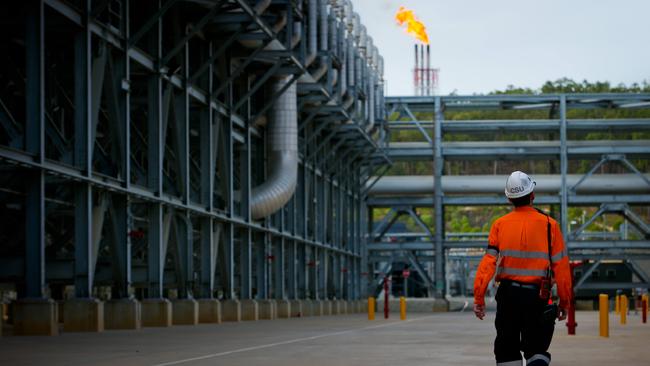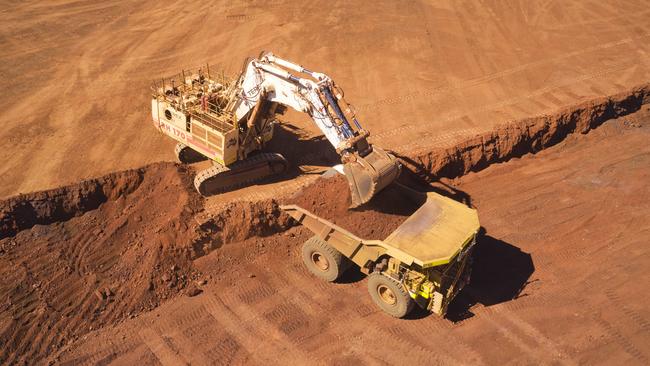Profit downgrade: ‘Mature’ Macquarie can’t shake its market instincts
The investment bank rode the commodities and markets bubble all the way up despite its best efforts to become more predictable.
Business
Don't miss out on the headlines from Business. Followed categories will be added to My News.
Macquarie Group is proof you can have too much of a good thing. The Australian investment bank rode the commodities and low-interest market bubble all the way up, and now is suffering a major hangover as the world attempts to get back to normal.
It was a rare profit warning – of sorts – from Macquarie as it faced shareholders. Chief executive Shemara Wikramanayake told the bank’s annual meeting that first quarter earnings were down substantially on the previous corresponding period.
The fall was mostly due to the windfall results the investment bank had in the prior period, as fee income and investment related income fell away in the new financial year. At the same time, investment income from its green energy bank failed to inspire. It all had shades that despite its efforts to build out mature businesses, Macquarie was still a market animal underneath.

And Wikramanayake suggested more weakness was to come this year, with three of Macquarie’s four big profit engines now facing a subdued outlook.
While Wikramanayake stopped short of providing a specific forecast, there are certainly questions about whether this could be the end of Macquarie’s remarkable record run of profit growth.
Macquarie’s shares were sold off Thursday, falling 4.4 per cent, with analysts likely to pare back their earnings forecasts.
A blip or more?
The key for shareholders is to understand whether Macquarie’s quarterly downturn is just a blip or it is likely to persist, like the GFC workout when the global economy underwent a long slow grind.
In the past decade, Macquarie’s profit reversed just once – in 2020 when the Covid pandemic hit – and even then it was mostly a timing issue given the bank has an end-March balance date.
Previously, its earnings have only fallen twice through the GFC years (but the bank was still profitable) and then there has been year-on-year profit growth going back decades.
Wikramanayake’s cautious comments follow a bumper 2023 financial year for Macquarie, where its energy trading business in Europe – largely built around gas transmission – powered the investment bank to a record $5.2bn profit last year.

That windfall was also shared with Nick O’Kane, Macquarie’s commodity boss who took home a $57.6m pay packet for the year. It was this one-year bonus that attracted investor ire and promoted a shareholder protest vote at Thursday’s annual meeting.
Macquarie is still haunted by its own excess during the GFC and Wikramanayake has been running hard to build on former chief executive Nicholas Moore’s efforts to make Macquarie a less volatile company than it had been in the past. As a rule, investment markets reward predictability. Some Wall Street banks such as Goldman Sachs have struggled to replicate smoother earnings by a push into wealth management, but others like Morgan Stanley under James Gorman have been more successful.
Wikramanayake said even with the earnings downturn, Macquarie was not becoming more volatile.
“Our business model remains consistent,” she says on a call. “We have four business lines, two of which we call annuity style and then two are market facing. They all face different drivers. And that’s what gives Macquarie really good diversification and strength and delivery of results from all cycles.”
However, it was a confluence of events from surging interest rates that has slowed investment and transaction volumes to cooling commodity markets that have meant a “substantially” weaker start to the year for three of those businesses.
Fund raising activity for infrastructure was subdued as investors are likely to be getting better returns in fixed income, but there’s also “an element of caution” about where interest rates are likely to land, the Macquarie chief said.
The one bright spot for Macquarie is banking, where first quarters were up given fast-paced earnings growth and improved interest margins.
“I don’t think there’s anything structural changed that has a permanent implication for Macquarie. We continue to have four really strong businesses great franchises that were growing organically, patiently and thriving underlying growth.”
Carbon crash
Rio Tinto has already backed away from its own near-term targets to slash carbon emissions by 2025 unless it uses carbon offsets.
And with a limited supply and lingering questions over the transparency of the Australian carbon credit scheme, going down this path would be a “last resort” says Rio chief executive Jakob Stausholm. Carbon credits too are seen as empty calories, which is essentially passing the carbon buck to someone else.

Rio told investors in London the miner was unlikely to achieve a targeted 15 per cent cut in Scope 1 (its direct) and Scope 2 (indirect) emissions by 2025. Stausholm said this shouldn’t be seen as the miner downgrading its carbon plans over growth, but it reflects the complexities of such an undertaking.
Rio might be the first major company to admit it is already starting to fall behind in meeting its own carbon reduction targets, but it most certainly won’t be the last.
High-inflation and a shortage of skilled labour while everyone is rushing at once for a 2030 deadline to strip out carbon, calls for a sobering reality check around some of the targets thrown around. And for Rio there was a lot of blue sky built into its own targets based around the hope that technology will deliver a faster solution down the track.
Of course there’s no penalty for missing anything ahead of 2030 but it is a strong reminder that the firm deadline is only seven years away. Any slippage from the end of decade target may see Rio come under pressure from its own shareholder base or even debt markets.
“We thought we could get to minus-15 (per cent ) … We’re just coming to the conclusion we can’t achieve it without credits because certain things take longer,” Stausholm told investors in London overnight.
Last December a government review of Australia’s carbon credit scheme found while the program was fundamentally sound there were major transparency and governance issues and thus was undermining investor confidence in the program.

Rio has a more complicated problem than its big mining rivals BHP and Fortescue. Rio operates two of Australia’s biggest electricity users – the Gladstone and Tomago aluminium smelters and combined they represent 50 per cent of Rio’s Australian carbon footprint. Getting these operations into line and are key to Rio hitting its 2030 targets.
Both are a long way from a reliable renewable energy supply and both are running out of time to find a solution. Rio this week slashed the value of the Australian aluminium assets by $US1.2bn, a writedown triggered by the Albanese government’s signature emissions reduction policy passed in March. However, Rio said other factors were also added into the writedown including the need to invest in the plans and slow path to decarbonisation.
Fortescue Mining’s new chief Fiona Hick says her iron ore miner is “totally focused on that goal to eliminate emissions” at the source and remains committed to its own ambitious 2030 targets.
Fortescue plans to spend more than $US6bn hitting “real” net zero emissions across its iron ore business by the end of the decade. To get there will involve a massive retooling of its haul truck fleet and iron ore trains to eliminate the use of diesel.
Rio’s Stausholm says he hasn’t decided whether or not to wade into the market for carbon credits. And there was still time to structure the business to hit the 2030 target of reducing emissions by 50 per cent from the baseline.
On the Australian smelting business, Stausholm wants to find a solution but warned without a green energy there won’t be a manufacturing or export case to support the plants.
johnstone@theaustralian.com.au
More Coverage
Originally published as Profit downgrade: ‘Mature’ Macquarie can’t shake its market instincts





